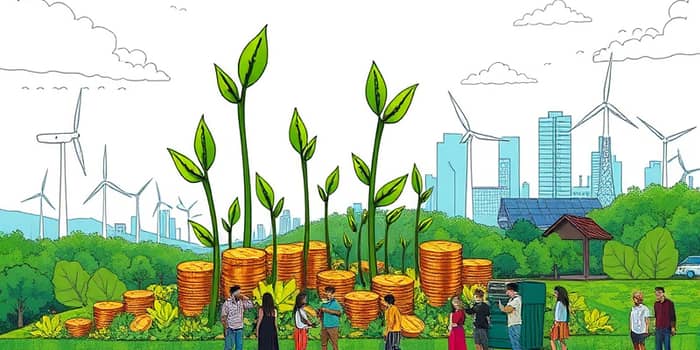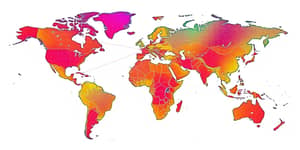The global financial landscape is undergoing a profound transformation. Stakeholders across sectors are recognizing the urgent need to redirect capital flows toward sustainable solutions. With mounting climate risks and social challenges, sustainable finance has moved from niche concept to mainstream priority. This article explores the latest innovations, market trends, and future outlooks driving this evolution.
Defining Sustainable Finance
Sustainable finance refers to the integration of environmental, social, and governance criteria into investment and lending decisions. It channels capital toward climate, biodiversity, social, and resilience goals, supporting a shift to low-carbon, inclusive economies.
By tying financial returns to real-world impact, sustainable finance fosters long-term value for investors and communities alike. It spans instruments, policies, and reporting frameworks designed to align economic growth with planetary boundaries and human well-being.
Key Innovations and Mechanisms
The sustainable finance toolkit is expanding rapidly. New instruments and structures unlock diverse sources of capital while managing risk and driving accountability.
- Funding renewable energy and sustainable infrastructure through green bonds.
- Emerging debt-for-nature swap mechanisms linking debt relief to conservation outcomes.
- Blended finance structures mobilize private capital with public guarantees.
- Sustainability-linked loans and bonds conditional on measurable performance targets.
- Expanding carbon markets with integrity safeguards to price emissions effectively.
Green bonds continue to lead growth, with primary issuance focused on renewable energy, sustainable transport, and resilient infrastructure. Blended finance draws in development banks and philanthropic investors to derisk projects and attract institutional capital.
Debt-for-nature swaps are gaining traction in vulnerable economies, tying relief to biodiversity preservation. Meanwhile, sustainability-linked products embed Key Performance Indicators into bond covenants and loan terms, incentivizing issuers to meet climate and social milestones.
Technology and Market Trends
Technological advancements are amplifying sustainable finance impacts. Fintech platforms streamline ESG data collection, verification, and reporting. Distributed ledger technology promises transparent tracking of green credentials, while AI accelerates decarbonization modeling.
On the market front, despite geopolitical and regulatory headwinds, demand for sustainable assets remains robust. In the EU, policy consolidation and taxonomy refinements guide capital toward credible solutions. The US sees polarized debates over ESG rules, with regulatory pushback and litigation risks. Emerging markets account for around 60% of new sustainable finance policy measures but often struggle with institutional capacity gaps.
- AI-driven decarbonization modeling for emission tracking transforms analysis.
- Fintech platforms enhance real-time ESG reporting.
- Investor caution rises amid inflation and interest rate volatility.
In Q2 2025, GSS+ bond issuance totaled $183 billion, driven by green bond growth but offset by declines in sustainability-linked bonds. Social bonds plateaued, reflecting evolving investor priorities and policy shifts.
Challenges and Policy Implications
Persistent barriers threaten to slow progress. Standardization gaps in reporting frameworks and taxonomies create confusion. Greenwashing risks undermine market confidence, prompting regulators to tighten disclosure requirements and enforce penalties.
ESG backlash, particularly in the US, illustrates how politics can shape regulatory landscapes. Divergent global policies complicate cross-border investment. Meanwhile, small and medium-sized enterprises face disproportionate burdens from emerging disclosure mandates.
To address these challenges, stakeholders must collaborate on harmonized standards, capacity building in emerging economies, and transparent verification processes. Enhanced due diligence and risk management will be critical as litigation over ESG claims intensifies.
Future Outlook
The road to a greener future hinges on scaling sustainable finance across geographies and sectors. Continued innovation, robust policy frameworks, and deepening investor engagement will determine success.
- Closing institutional and capacity gaps to support emerging markets.
- Standardize ESG reporting and taxonomy definitions for global consistency.
- Scale green bond and blended finance structures to mobilize trillions.
- Foster cross-border policy alignment and tech innovation for resilience.
By aligning financial incentives with environmental and social imperatives, sustainable finance can catalyze transformative investments. From renewable energy and clean transport to biodiversity conservation and inclusive growth, these innovations pave the way toward a resilient, low-carbon future. The collective momentum of investors, policymakers, and society offers a powerful opportunity to reimagine capital markets as engines of positive change.
References
- https://www.rbccm.com/en/story/story.page?dcr=templatedata%2Farticle%2Fstory%2Fdata%2F2024%2F12%2Fsfg-themes-2025
- https://www.apexgroup.com/insights/the-future-of-sustainable-finance-key-trends-for-2025-and-beyond/
- https://tisegroup.com/news/2025/sustainable-finance-in-2025-the-great-reset/
- https://www.cliffordchance.com/insights/thought_leadership/trends/2025/sustainability-esg-trends-2025.html
- https://www.oecd.org/en/topics/sub-issues/sustainable-finance.html
- https://www.iss-corporate.com/resources/blog/july-2025-sustainable-finance-market-highlights/










